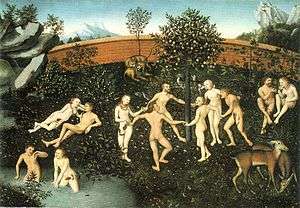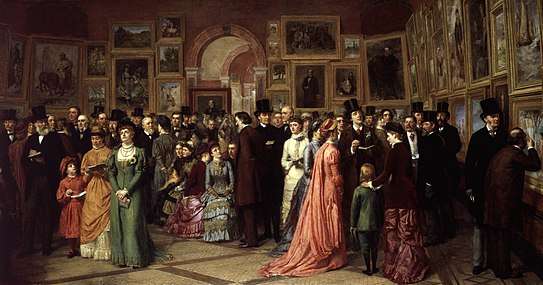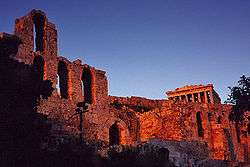Golden age (metaphor)
A golden age is a period in a field of endeavor when great tasks were accomplished. The term originated from early Greek and Roman poets, who used it to refer to a time when mankind lived in a better time and was pure (see Golden Age).

The ancient Greek philosopher Hesiod introduced the term in his Works and Days, when referring to the period when the "Golden Race" of man lived. This was part of fivefold division of Ages of Man, starting with the Golden age, then the Silver Age, the Bronze Age, the Age of Heroes (including the Trojan War), and finally, the current Iron Age.[1] The concept was further refined by Ovid, in his Metamorphoses, into the four "metal ages" (golden, silver, bronze, and iron).[2]
The Golden age in Classic literature

The Golden age as described by Hesiod was an age where all humans were created directly by the Olympian gods. They did not have women in their ranks, and could not reproduce. They lived long lives in peace and harmony, and were oblivious of death. The "Golden race" were however mortals, but would die peacefully and in their sleep unmarked by sickness and age.[1] Ovid emphasizes the justice and peace that defined the Golden Age. He described it as a time before man learned the art of navigation, and as a pre-agricultural society.[3] The idea of a Golden age lingered in literature and historical understanding throughout the Greek and Roman periods.[4] It was partly replaced by the Christian Six Ages of the World based on the biblical chronology in the early Middle Ages.[5]
Evolution from period to metaphor
The term "Golden age" has always had a metaphoric element. A few centuries after Hesiod, Plato pointed out that the "Golden race" were not made from gold as such, but that the term should be understood metaphorically.[6] The classical idea of the "metal ages" as actual historical periods held sway throughout the Greek and Roman periods.[4] While supplemented by St. Augustine's "Six Ages of the World", the classical ideas were never entirely eradicated, and it resurfaced to form the basis of division of time in early archaeology.[5]
At the birth of modern archaeology in the 18th century, the "Golden age" was associated with a pre-agricultural society. However, already in the 16th century, the term "Golden age" was replaced by "Stone Age" in the three-age system.[7][8] Still, Rousseau used the term for a loosely defined historical period characterized by the "State of nature" as late as the during the late 18th century.[9] While the concept of an Iron and Bronze Age are still used by historians and archaeologists, the "Golden age" of Hesiod was a purely mythical period, and has come to signify any period in history where the state of affairs for a specific phenomenon appear to have been on their height, better than in the periods proceeding it and following the "Golden Age". It is sometimes still employed for the hunter-gatherer tribal societies of the Mesolithic, but only as a metaphor.[10]
Golden Age in society timeline
A society's Golden Age marks that period in its history having a heightened output of art, science, literature, and philosophy.
- Ancient Egypt experienced several Golden Ages including the Fourth Dynasty during the Old Kingdom, as well as the New Kingdom.
- Athenian Golden Age presided by Pericles
- Golden age of Latin literature, the period in Latin literature between Cicero and Ovid.
- Golden age of India, the period between the 3rd century to the 6th century CE under the leadership of the Gupta Empire, during which Indians made great achievements in mathematics, science, culture, religion, philosophy and astronomy.
- Early Christian Ireland, when Ireland was united under one High King and was significant in European art
- Islamic Golden Ages
- Reign of Harun al-Rashid (786–809), the height of the Abbasid Caliphate, before the Fourth Fitna, the Anarchy at Samarra, and the onset of political fragmentation
- From the beginning of Islam (622) until the sack of Baghdad by the Mongols (1258) in the Arab world
- Reignited in the 14th century in the Age of the Islamic Gunpowders (Ottoman, Safavid, and Mughal Empires) until the early 17th century.
- Golden Age of Bulgaria, the reign of Emperor Simeon I the Great, late 9th – early 10th centuries.
- Golden age of Kiev, 10th century
- China has had multiple golden ages, with the Han, Tang, Song, and Ming all considered golden ages in Chinese history. The "Chinese Golden Age" is used to refer to the period of the Tang and Song Dynasties from 618 to 1279, which saw an economic revolution.
- Golden age of Jewish culture in the Iberian Peninsula period between 900 and 1100. Sometimes categorized as part of the larger Islamic Golden Age, because of the event's timeframe and geography.
- Golden age of Christian Monasticism, 8th–12th centuries, its peak being 11th century to early-mid 12th century. Understood to be a Golden age in the European continent of strictly religious matters, and not in comparison to other Golden ages of the era.
- Golden Age of medieval Bulgarian culture, golden age in Bulgaria.
- Georgian Golden Age, the period of prosperity and cultural flourishing in the Kingdom of Georgia in the 11th, 12th, and early 13th centuries, especially under Queen Tamar the Great
- Golden Age in Indonesian history from about 1293 to around 1500 when the Hindu–Buddhist Majapahit kingdom in eastern Java, under Gajah Mada, extended its influence to much of southern Malay Peninsula, Borneo, Sumatra, and Bali.
- Second Golden Age of Bulgaria – prosperity of Bulgarian culture, literature and arts during Emperor Ivan Alexander (1331–1371)
- Portuguese Golden Age, 15th century – 1580. One of the best European power of the time in sailing.[lower-alpha 1]
- Golden age of Valencian literature, 15th Century
- Ottoman Golden Age, 1480s–1560s, partly under the reign of Suleiman the Magnificent.
- The High Renaissance of the 16th century is often described as the "golden age" of the culture and art of Renaissance Italy.
- The history of Malta under the Order of Saint John (1530–1798) is generally considered as a "golden age" of architecture, the arts, health and education, especially between the late 1560s and the early 1770s.[11]
- Spanish Golden Ages – Siglo de oro:
- the powerful Spanish Empire between 16th and 17th centuries
- the later Spanish Golden Age of the arts in the 17th century
- English Golden Ages
- The "Golden Age of England" is the Elizabethan Era, under Elizabeth I of England, in the late 16th century
- The "Golden Age of Britain" is the Victorian Era, under Queen Victoria, in the 19th century[lower-alpha 2]
 The Victorian era is often cited as the Golden Age of Britain
The Victorian era is often cited as the Golden Age of Britain
- Polish Golden Age, 16th century, early 17th century
- Dutch Golden Age, 17th century, approximately 1588–1672
- Golden Age of Dutch Painting, spanning the 17th century
- Golden age of Belarusian history, 1500s–1570s, esp. 1550s–1570s
- Grand Siècle, the reigns of Louis XIII and Louis XIV.
- The Golden Age of Piracy, 1650–1730
 The Forty-seven Ronin, one of the best known themes from the Japanese Golden Age
The Forty-seven Ronin, one of the best known themes from the Japanese Golden Age - The Genroku era (1688–1704) in Japan is widely considered a "golden age" for literature, drama, and the arts
- Danish Golden Age, first half of the 19th century
- Golden Age of Russian Poetry, first half of the 19th century, with Russian poets Pushkin, Lermontov, Tyutchev and others
- Golden Age of Capitalism, a period of rapid growth in the economies of the west, and Japan, from 1945 to 1970. Also used for the Gilded Age of the late 19th century
- The Golden Twenties, the 1920s in Europe, the Roaring Twenties were the American equivalent
- In the United States, multiple periods in the 20th century are considered, usually from 1945 to 1963.
- Likewise in the United States, the American Century may be taken to represent a golden age of global cultural influence and political hegemony
Culture and technology
A golden age is often ascribed to the years immediately following some technological innovation. During this time writers and artists ply their skills in this new medium. Therefore, there are Golden Ages of both radio and television. During such a nascent phase the technology allows new ideas to be expressed, as new art-forms flower quickly into new areas:
- Golden age of illustration, a period in US illustration history from the 1880s to the 1910s.
- The Golden Age of Radio, 1920s–1940s
- The Golden Age of American animation, between 1928 (sound) and the 1960s (television).
- The Golden Age of Hollywood, which lasted from the end of the silent era in American cinema in the late 1920s to the early 1960s
- Golden Age of Television (referring to U.S. television circa 1950s) when television was still a fairly recent invention. Programs such as Kraft Television Theatre, Playhouse 90, and later Alfred Hitchcock Presents and The Twilight Zone brought a level of writing to American commercial television that would rarely be seen in the next several decades.
- Golden Age of Pornography, refers to a 15-year period (around 1969–1984) in commercial American pornography, which spread internationally,[12][13] in which sexually-explicit films experienced positive attention from mainstream cinemas, movie critics, and the general public.[14][15][16] It began with release of the 1969 film Blue Movie directed by Andy Warhol,[17][18][19] and the 1970 film Mona produced by Bill Osco.[14][20] These films were the first adult erotic films depicting explicit sex to receive wide theatrical release in the United States.[17][18][19][20] During this period, pornographic films emerged from underground studios, and became a full-scale industry with aspirations towards mainstream cinema.
- Golden Age of the Music Video, 1975–2000,[21] a period that started with the release of "Bohemian Rhapsody" by Queen
- Golden Age of Arcade Video Games, the late 1970s to 1980s
- Golden age of anime, 1982–1997 (from 24 frames per second to the beginning of the CGI era)
- Golden Era of Spanish Software, 1983–1992
- The Golden Age of Radio-Controlled Buggies, 1983–1992. A period when model companies shifted towards practical electric-powered buggies, leading to numerous companies (including toy manufacturers) entering the market and helping it to become the dominant class.
- Golden age of hip hop, 1988–1994 a period when hip-hop music was arguably at its creative and artistic peak
- Golden age of PC Games, 1990 to the early 2000s
- Second Golden Age of Television, 1999–present, a period of high-quality and often scripted American television programming that started with The Sopranos, The Wire, Breaking Bad, and Mad Men (among others)
- Golden Age of Viral Videos, 2005–present, a period that started with the launch of YouTube and continues today.[21]
- Golden Age of Muscle Car, 1964–1972.[22][23][24][25]
At least one technology had its "Golden Age" in its latter years:
- The Golden Age of Sail, 19th century.
A cultural "golden age" can feature in the construction of a national myth.[26]
Genre
Technology and creativity spawn new genres in literature and theatre. The onset of a new genre will be its Golden Age:
- Golden Age of Broadway, the period from about 1943 to 1968 that brought musicals like Oklahoma! (1943); Kiss Me, Kate (1948); West Side Story (1957); The Sound of Music (1959); and Hello, Dolly! (1964) to the Broadway stage
- Golden Age of British dance bands, 1920s–1930s
- Golden Age of the British whodunit, early 20th century
- Golden Age of Comic Books, period between roughly 1938 and 1945, though exact definitions vary
- Golden Age of Mexican cinema, beginning in 1935 and ending in the late 1950s
- Golden Age of Detective Fiction, an era of detective fiction between World Wars I and II, epitomised by Agatha Christie.
- Golden age of the Italian horror movie (c. 1957–1979)
- Golden Age of romantic comedies, 1990s
- Golden Age of Science Fiction, period from the late 1930s through the 1950s
- Golden age of Swordplay, period of sword skills between 16th and 18th century
- Golden Age of the Western, of the Western movie, 1930s–1960s
Science
- The Golden age of general relativity, upon its entering the mainstream of theoretical physics, 1960–1975.
Senior citizen
Companies will use "Golden Age" as a marketing euphemism to replace "senior citizen":
- Golden Age Passport, a National Park Service pass for citizens who are 62 or older.
Sport
- The golden age of alpinism (1854–1865), during which many major Alpine peaks saw their first ascents.
- The Golden Age of cricket (1890–1914)
- Golden age of baseball (1920–1960)
- Golden Age of Roller Skating (1937–1959)
- Golden Age of Trans-Am Series (1968–1972)
- Golden Age of Rallying (1983–1986). A period where car manufacturers were given carte blanche in terms of vehicle design, resulting in spectacular high powered cars that drew the sport to the height of its popularity.
See also
- Gilded Age
- Heroic Age (disambiguation)
- Silver age
- Bronze Age (disambiguation)
Notes
- See also: Portuguese Renaissance
- See also: Pax Britannica
Sources
- Bartlett, R.C. (2006). "An Introduction to Hesiod's Works and Days". The Review of Politics. 68 (2): 177–205. doi:10.1017/S003467050600009X.
- Ovid, Metamorphoses. Trans. A.D. Melville. Oxford: Oxford University Press, 1986. pp. ix–xi
- McDermott, E. (2011). "'The Metal Face of the Age': Hesiod, Vergil, and the Iron Age on Cold Mountain". International Journal of the Classical Tradition. 17 (2): 244–256. doi:10.1007/s12138-010-0186-3. Archived from the original on 2011-02-25.
- St. Jerome. "St. Jerome, Chronicle (2004-5). Preface of Jerome; Preface of Eusebius". Tertullian.org. Retrieved 2012-11-16.
- Graeme Dunphy (2010). "Six Ages of the World". In Graeme Dunphy (ed.). Encyclopedia of the Medieval Chronicle. Leiden: Brill. pp. 1367–1370. ISBN 90 04 18464 3.
- Boys-Stones, edited by G.R.; Haubold, J.H. (2010). Plato and Hesiod ([Online-Ausg.] ed.). Oxford: Oxford University Press. ISBN 978-0199236343.CS1 maint: extra text: authors list (link)
- Goodrum, Matthew R. (2008). "Questioning Thunderstones and Arrowheads: The Problem of Recognizing and Interpreting Stone Artifacts in the Seventeenth Century". Early Science and Medicine. 13 (5): 482–508. doi:10.1163/157338208X345759.CS1 maint: ref=harv (link)
- Gräslund, Bo (1987). The Birth of Prehistoric Chronology. Dating methods and dating systems in nineteenth-century Scandinavian archeology. Cambridge: Cambridge University Press.CS1 maint: ref=harv (link)
- Hartzog, P.B. "Rousseau and Marx on Equality: Paradise Lost, Paradise Restored" (PDF). The University of Utah. Archived from the original (PDF) on 10 May 2012. Retrieved 30 October 2012.
- David Maybury-Lewis (1992). Millennium : tribal wisdom and the modern world. New York: Viking. ISBN 0-670-82935-8.
- "The culture of Malta throughout the millenia". malta.com. Retrieved 7 May 2015.
- Paasonen, Susanna; Saarenmaa, Laura (July 19, 2007). The Golden Age of Porn: Nostalgia and History in Cinema (PDF). WordPress. Retrieved April 30, 2017.
- DeLamater, John; Plante, Rebecca F., eds. (June 19, 2015). Handbook of the Sociology of Sexualities. Springer Publishing. p. 416. ISBN 9783319173412. Retrieved April 30, 2017.
- Corliss, Richard (March 29, 2005). "That Old Feeling: When Porno Was Chic". Time. Retrieved January 27, 2016.
- Ebert, Roger (June 13, 1973). "The Devil In Miss Jones – Film Review". RogerEbert.com. Retrieved February 7, 2015.
- Ebert, Roger (November 24, 1976). "Alice in Wonderland: An X-Rated Musical Fantasy". RogerEbert.com. Retrieved February 26, 2016.
- Canby, Vincent (July 22, 1969). "Movie Review – Blue Movie (1968) Screen: Andy Warhol's 'Blue Movie'". New York Times. Retrieved December 29, 2015.
- Canby, Vincent (August 10, 1969). "Warhol's Red Hot and 'Blue' Movie". New York Times. p. D1. Retrieved December 29, 2015.(subscription required)
- Comenas, Gary (2005). "Blue Movie (1968)". WarholStars.org. Retrieved December 29, 2015.
- "Pornography". Pornography Girl. Archived from the original on May 6, 2008. Retrieved July 16, 2013.
The first explicitly pornographic film with a plot that received a general theatrical release in the U.S. is generally considered to be Mona (Mona the Virgin Nymph)...
- "Welcome to the New Golden Age of Music Videos".
- "Muscle Cars: The Stars from the Golden Age of Hot Rods". WheelScene. 2016-02-09. Retrieved 2019-12-30.
- "Muscle Car History: Understand How They Came to Be". CarsDirect. Retrieved 2019-12-30.
- "How Muscle Cars Work". HowStuffWorks. 2007-01-16. Retrieved 2019-12-30.
- Benz, Robert. "Muscle Cars Explained: History, Evolution & Buyer's Guide". Gentleman's Gazette. Retrieved 2019-12-30.
-
For example:
McCarthy, Conal (2007). Exhibiting Māori: a history of colonial cultures of display. Berg. p. 62. ISBN 9781845204747. Retrieved 6 October 2019.
Maori intellectuals [collaborated] in the staging of a Maori golden age [...].
